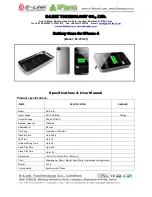
Confidential
USERS MANUAL
27(158)
Document number
Revision
1/198 17-4/FCP 101 3045 Uen
D
notification that the CM52 has successfully shut down; the CM52 is in an unknown failure state. SEMC can
not provide any guidance, for the module is in an unaccountable state. Should power be removed after this
failure point, it is recommended that the module be power cycled before declaring the CM52 has failed. The
CM52 has several backup/restore mechanisms that should successfully restore the module to its previous
working condition, however, since this error state is undefined, it is not possible to guarantee that the unit will
boot-up properly.
4 AT
Commands
The first part of this chapter, 4.1 General description of AT commands, provides an overview of how to use AT
commands on a CM52 module. The rest of this chapter provides detailed descriptions of the AT commands
supported by CM52.
The functionality and syntax as well as expected result codes and responses are documented for each
command.
4.1
General description of AT commands
The purpose of this chapter is to describe how the AT commands are used in CM52.
4.1.1 Overview
AT commands are commonly used to communicate with modem equipment. For the CM52, the AT
commands are used for communication over the serial link between the CM52 and a host application. The
format of the AT commands is ASCII strings that always start with AT and end with a defined set of characters.
The format is defined in detail later on in this chapter.
The communication from the host application to CM52 is synchronous: the host application has to wait for a
result code before issuing the next command. The behavior of the CM52 is undefined if a new command is
issued before the previous command’s result code is returned. The communication from CM52 to the host
application is both synchronous and asynchronous. A result code is always returned when a command from
the host application has executed. There are also unsolicited responses are sent to the host application when
a certain event has occurred.
SEMC supports only the AT commands listed in this document. Other AT commands may be functional as a
result of the baseline code, but they will not be supported by SEMC. The status of undocumented commands
should not be assumed. It is recommended that only the listed AT commands be used in an application.
Note:
the test command option associated with AT commands may also be present for several AT
commands. SEMC will not support the test command feature within the CM52.
4.1.2 Command
types
The AT command manual uses the following terminology for the different kinds of communication strings:
•
AT command
This is referred to as a command from the host application to CM52 with a request to perform a
service.
•
Result code
This is an immediate response to a command, informing the host application whether the execution of
the command succeeded or failed. The strings “OK” or “ERROR” are the only two Result Codes
available. A result code is always returned after an AT command has been sent to the CM52.
•
Extended Reason Code
If enabled, (see AT+CMEE), CM52 responds with a detailed reason code string in addition to “OK” or
“ERROR”. The reason code is returned before the commands result code. Extended reason codes
are only provided when the result code is ERROR.















































